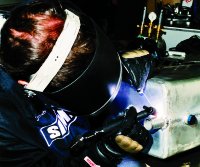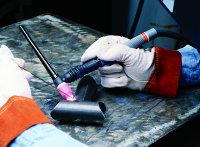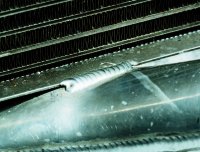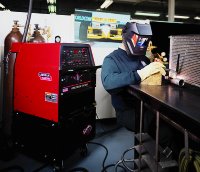Precision TIG Series 1: Arc Performance
When Lincoln Electric set out to design the next generation of its TIG welding machines, the design team was committed to addressing key issues for TIG-intensive customers. To do this, the team conducted in-depth interviews with many different customers in a variety of industry segments, as well as welding industry distributors and sales personnel. Interviewees were asked what day-to-day problems they were experiencing with their current TIG machines and also what features would make their welding easier.
From these interviews, Lincoln Electric learned what problems and challenges welders encounter on a daily basis and then set out to design innovative solutions to meet these needs. After designing prototypes and extensive field testing, Lincoln Electric introduced the new Precision TIG® family of TIG power sources.
We have developed a series of articles on the Precision TIG welders to detail what makes them your best choice in class for TIG welding. In each of these articles, we will focus on a different aspect of the machine and how it brings advantages to the operator in terms of arc performance, ease of use, set-up, reliability/serviceability, power consumption and price and value. Part one of the series discusses the design of this machine and its arc performance.
Arc Performance
Customers revealed that outstanding arc performance was the number one requirement for their TIG welder. But what actually defines good arc performance? Lincoln Electric confirmed and customers agreed that these were the top operator concerns:
1. Excellent starting performance
2. The ability to weld at low amperages
3. Crater fill capabilities to end the weld with precise control and without the high frequency reestablishing
4. A smooth, stable arc with minimal AC rectification across a wide welding range
5. Expanded balance range to narrow the cleaning zone adjacent to the weld
Let’s take a look at how the Precision TIG with its Micro-Start Technology II™ delivers superb arc performance.
1. Excellent Starting Performance
Most failures in TIG welding occur at the beginning and ending of a weld. When you consider that TIG welding is typically the welding process of choice for very critical and expensive applications, having a machine capable of the best starting performance is paramount. Most TIG machines use high frequency to establish the arc. Although this accomplishes arc initiation, in most DC TIG machines the high frequency remains on for a long duration and with a high intensity until the arc stabilizes. This can create tracking marks on the weld surface which, for some applications in the aerospace industry, is viewed as a weld rejection. To improve arc starting, some competitive TIG machines use a ‘Hot Start’ feature. Hot Start utilizes a silicon controlled rectifier (SCR) to conduct spikes of high current to start the arc more quickly and reduce the duration of high frequency. However, this method can also be problematic on thin materials because Hot Start can uncontrollably melt away the base material.
With the Precision TIG and its innovative Micro-Start II technology, Lincoln Electric has devised a way to get the arc established more quickly, more smoothly and with greater stability. It does this using an electronic low amp welding power supply to supplement the main power supply. The starting circuit offers just enough energy to heat the tungsten and establish a more stable plasma flow to the work piece. This starting sequence is short and provides precise control over starting conditions. In effect, Micro-Start II technology is so effective that most operators cannot detect that the high frequency was used during starting.
2. The Ability to Weld at Low Amperages
Since TIG is often used in applications that require very precise control of heat input, such as thin weldments, or aerospace, nuclear piping and motorsports, it is critical to have excellent low-end control. During the interviewing process, Lincoln determined that customers required a machine that could start and weld down to a 5 amp minimum – though a machine that could weld even lower was preferred.
In many traditional, low amperage TIG applications, operators have trouble maintaining a smooth, stable arc. This is because the machine's choke cannot store enough energy between SCR firings to stabilize the arc. The resultant ‘ripple effect’ creates arc instability, which may result in arc outages followed by high-frequency arc re-initiations. These erratic outages can lead to inconsistencies in the weld.
Micro-Start TIG utilizes a separate electronic power supply to establish an arc and weld at the Precision TIG minimum rated amps. When the operator first depresses the foot pedal, this separate power supply starts and welds independently of the Precision TIG main welding circuit (i.e. transformer and SCR bridge). As the operator further depresses the foot pedal to increase the current, the main welding circuit turns on and provides additional amperage. Unlike conventional machines, which rely completely on the SCR choke, Micro-Start technology’s special electronic welding circuit assists the transformer SCR choke circuit by delivering smooth power to the arc. This gives the Precision TIG very stable low-current welding capability and provides the customer with the ability to weld thin materials in a consistent, high-quality manner.
3. Crater Fill
Because most failures occur in weld starts and stops, the need for precise crater fill is also imperative. One of the most frequent complaints TIG operators voiced was the problem associated with lowering the current to fill a crater at the end of the weld.

Operators want to have a stable, smooth controllable ramp down to a minimum amperage level. Additionally, in DC, they don’t want the high frequency coming back on creating a wandering or “dancing” arc that leaves unwanted surface conditions or irregularities on the weld, which in some industries, can be viewed as a weld rejection.
Micro-Start II provides the operator with the ability to weld at lower DC amperages and “feather out” to as low as 2-5 amps at the end of the weld. Also, once the high frequency initiates the DC arc, the control circuit prevents the high frequency from coming on again during crater fill. In effect, the high frequency is no longer needed because Micro-Start technology provides tremendous low amperage stability for the machine.
For AC welding, the stability of the Precision TIG’s control circuit allows the AC output to have a smooth, controlled ramp down to as low as 5 amps.
The Precision TIG’s ability to precisely crater out 5 amps makes it ideal for edge build up and repair applications such as aerospace turbine blades, marine propellers and motorsports airfoils and spoilers. Contrast this to many other conventional machines that weld only as low as 5 amps on DC and 10 amps AC.
4. Smooth, Stable Arc with Minimal AC Rectification
When AC welding with conventional power sources, it is not uncommon to have a condition commonly known as AC rectification. The physics of a TIG arc is such that electrons flow easier from the electrode to the work than from the work to the electrode. As a result, the positive half of the AC output is sometimes rectified (or blocked). This rectification of the arc can be observed as flutter in the arc. The Precision TIG has an improved choke design combined with a stable control circuit to help compensate for rectification. The result is an extremely smooth and stable AC arc.
5. Expanded Balance Range to Narrow the Cleaning Zone
When welding on materials such as aluminum, the operator needs to balance penetration (the negative portion of the AC output) and cleaning (the positive portion of the AC output). If the operator favors cleaning, the weld will have a wide cleaning zone seen as a white, frosted edge next to the weld bead. For industries such as aerospace, this cleaning zone is viewed as a surface condition that can lead to weld rejection. Therefore, it is desirable to be able to adjust the AC-balance more toward penetration to minimize this zone. The Precision TIG has an extended AC-balance range allowing the operator to manually adjust the balance to less cleaning action if the particular application demands it.
Conclusion
By listening to the customer’s needs, Lincoln Electric continues to develop expert innovative solutions. With the Precision TIG family of product, Lincoln Electric defines the standard in the TIG industry and delivers the "Power to Perform".




